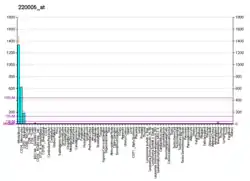P2RY13
P2Y purinoceptor 13 is a protein that in humans is encoded by the P2RY13 gene.[5][6][7]
| P2RY13 | |||||||||||||||||||||||||||||||||||||||||||||||||||
|---|---|---|---|---|---|---|---|---|---|---|---|---|---|---|---|---|---|---|---|---|---|---|---|---|---|---|---|---|---|---|---|---|---|---|---|---|---|---|---|---|---|---|---|---|---|---|---|---|---|---|---|
| |||||||||||||||||||||||||||||||||||||||||||||||||||
| Identifiers | |||||||||||||||||||||||||||||||||||||||||||||||||||
| Aliases | P2RY13, GPCR1, GPR86, GPR94, P2Y13, SP174, FKSG77, purinergic receptor P2Y13 | ||||||||||||||||||||||||||||||||||||||||||||||||||
| External IDs | OMIM: 606380 MGI: 1921441 HomoloGene: 12543 GeneCards: P2RY13 | ||||||||||||||||||||||||||||||||||||||||||||||||||
| |||||||||||||||||||||||||||||||||||||||||||||||||||
| |||||||||||||||||||||||||||||||||||||||||||||||||||
| |||||||||||||||||||||||||||||||||||||||||||||||||||
| |||||||||||||||||||||||||||||||||||||||||||||||||||
| |||||||||||||||||||||||||||||||||||||||||||||||||||
| Wikidata | |||||||||||||||||||||||||||||||||||||||||||||||||||
| |||||||||||||||||||||||||||||||||||||||||||||||||||
The product of this gene, P2Y13, belongs to the family of G-protein coupled receptors. This family has several receptor subtypes with different pharmacological selectivity, which overlaps in some cases, for various adenosine and uridine nucleotides. This receptor is activated by ADP. Two transcript variants encoding the same protein have been identified for this gene.[7]
See also
References
- GRCh38: Ensembl release 89: ENSG00000181631 - Ensembl, May 2017
- GRCm38: Ensembl release 89: ENSMUSG00000036362 - Ensembl, May 2017
- "Human PubMed Reference:". National Center for Biotechnology Information, U.S. National Library of Medicine.
- "Mouse PubMed Reference:". National Center for Biotechnology Information, U.S. National Library of Medicine.
- Wittenberger T, Schaller HC, Hellebrand S (Mar 2001). "An expressed sequence tag (EST) data mining strategy succeeding in the discovery of new G-protein coupled receptors". J Mol Biol. 307 (3): 799–813. doi:10.1006/jmbi.2001.4520. PMID 11273702.
- Lee DK, Nguyen T, Lynch KR, Cheng R, Vanti WB, Arkhitko O, Lewis T, Evans JF, George SR, O'Dowd BF (Sep 2001). "Discovery and mapping of ten novel G protein-coupled receptor genes". Gene. 275 (1): 83–91. doi:10.1016/S0378-1119(01)00651-5. PMID 11574155.
- "Entrez Gene: P2RY13 purinergic receptor P2Y, G-protein coupled, 13".
Further reading
- Communi D, Gonzalez NS, Detheux M, et al. (2001). "Identification of a novel human ADP receptor coupled to G(i)". J. Biol. Chem. 276 (44): 41479–85. doi:10.1074/jbc.M105912200. PMID 11546776.
- Zhang FL, Luo L, Gustafson E, et al. (2002). "P2Y(13): identification and characterization of a novel Galphai-coupled ADP receptor from human and mouse". J. Pharmacol. Exp. Ther. 301 (2): 705–13. doi:10.1124/jpet.301.2.705. PMID 11961076.
- Takeda S, Kadowaki S, Haga T, et al. (2002). "Identification of G protein-coupled receptor genes from the human genome sequence". FEBS Lett. 520 (1–3): 97–101. doi:10.1016/S0014-5793(02)02775-8. PMID 12044878. S2CID 7116392.
- Strausberg RL, Feingold EA, Grouse LH, et al. (2003). "Generation and initial analysis of more than 15,000 full-length human and mouse cDNA sequences". Proc. Natl. Acad. Sci. U.S.A. 99 (26): 16899–903. Bibcode:2002PNAS...9916899M. doi:10.1073/pnas.242603899. PMC 139241. PMID 12477932.
- Fabre AC, Malaval C, Ben Addi A, et al. (2010). "P2Y13 receptor is critical for reverse cholesterol transport". Hepatology. 52 (4): 1477–83. doi:10.1002/hep.23897. PMID 20830789. S2CID 5833128.
External links
- "P2Y Receptors: P2Y13". IUPHAR Database of Receptors and Ion Channels. International Union of Basic and Clinical Pharmacology.
This article incorporates text from the United States National Library of Medicine, which is in the public domain.
This article is issued from Wikipedia. The text is licensed under Creative Commons - Attribution - Sharealike. Additional terms may apply for the media files.




